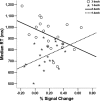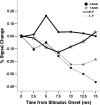Individual differences in amygdala activity predict response speed during working memory
- PMID: 17021168
- PMCID: PMC1851922
- DOI: 10.1523/JNEUROSCI.2567-06.2006
Individual differences in amygdala activity predict response speed during working memory
Abstract
The human amygdala has classically been viewed as a brain structure primarily related to emotions and dissociated from higher cognition. We report here findings suggesting that the human amygdala also has a role in supporting working memory (WM), a canonical higher cognitive function. In a first functional magnetic resonance imaging (fMRI) study (n = 53), individual differences in amygdala activity predicted behavioral performance in a 3-back WM task. Specifically, higher event-related amygdala amplitude predicted faster response time (RT; r = -0.64), with no loss of accuracy. This relationship was not contingent on mood state, task content, or personality variables. In a second fMRI study (n = 21), we replicated the key finding (r = -0.47) and further showed that the correlation between the amygdala and faster RT was specific to a high working memory load condition (3-back) compared with a low working memory load condition (1-back). These results support models of amygdala function that can account for its involvement not only in emotion but also higher cognition.
Figures







Similar articles
-
Performance dissociation during verbal and spatial working memory tasks.Percept Mot Skills. 2007 Aug;105(1):243-50. doi: 10.2466/pms.105.1.243-250. Percept Mot Skills. 2007. PMID: 17918571
-
Individual differences in neural activity during a facial expression vs. identity working memory task.Neuroimage. 2011 Jun 1;56(3):1685-92. doi: 10.1016/j.neuroimage.2011.02.051. Epub 2011 Feb 22. Neuroimage. 2011. PMID: 21349341 Free PMC article.
-
Cognitive versus automatic mechanisms of mood induction differentially activate left and right amygdala.Neuroimage. 2011 Feb 1;54(3):2503-13. doi: 10.1016/j.neuroimage.2010.10.013. Epub 2010 Oct 12. Neuroimage. 2011. PMID: 20946960
-
A parametric study of prefrontal cortex involvement in human working memory.Neuroimage. 1997 Jan;5(1):49-62. doi: 10.1006/nimg.1996.0247. Neuroimage. 1997. PMID: 9038284
-
The amygdala and the Prince of Denmark.Trends Pharmacol Sci. 1988 Dec;9(12):429-30. doi: 10.1016/0165-6147(88)90126-5. Trends Pharmacol Sci. 1988. PMID: 3078083 Review. No abstract available.
Cited by
-
Reward prediction error signal enhanced by striatum-amygdala interaction explains the acceleration of probabilistic reward learning by emotion.J Neurosci. 2013 Mar 6;33(10):4487-93. doi: 10.1523/JNEUROSCI.3400-12.2013. J Neurosci. 2013. PMID: 23467364 Free PMC article.
-
Working memory overload: fronto-limbic interactions and effects on subsequent working memory function.Brain Imaging Behav. 2010 Mar;4(1):96-108. doi: 10.1007/s11682-010-9089-9. Brain Imaging Behav. 2010. PMID: 20503117 Free PMC article.
-
Uncertainty and cognitive control.Front Psychol. 2011 Sep 3;2:249. doi: 10.3389/fpsyg.2011.00249. eCollection 2011. Front Psychol. 2011. PMID: 22007181 Free PMC article.
-
Paradoxical facilitation of working memory after basolateral amygdala damage.PLoS One. 2012;7(6):e38116. doi: 10.1371/journal.pone.0038116. Epub 2012 Jun 8. PLoS One. 2012. PMID: 22715374 Free PMC article. Clinical Trial.
-
Association between subcortical nuclei volume changes and cognition in preschool-aged children with tetralogy of Fallot after corrective surgery: a cross-sectional study.Ital J Pediatr. 2024 Sep 19;50(1):189. doi: 10.1186/s13052-024-01764-0. Ital J Pediatr. 2024. PMID: 39300569 Free PMC article.
References
-
- Anderson JR. Cambridge, MA: Harvard UP; 1983. The architecture of cognition.
-
- Barch DM. Pharmacological manipulation of human working memory. Psychopharmacology (Berl) 2004;174:126–135. - PubMed
-
- Braver TS, Cohen JD. On the control of control: the role of dopamine in regulating prefrontal function and working memory. In: Monsell S, Driver J, editors. Attention and performance. XVIII. Cambridge, MA: MIT; 2000. pp. 713–738.
-
- Braver TS, Ruge H. Functional neuroimaging of executive functions. In: Cabeza R, Kingstone A, editors. Functional neuroimaging of cognition. Cambridge, MA: MIT; 2006. pp. 307–347.
Publication types
MeSH terms
Grants and funding
LinkOut - more resources
Full Text Sources
Medical
